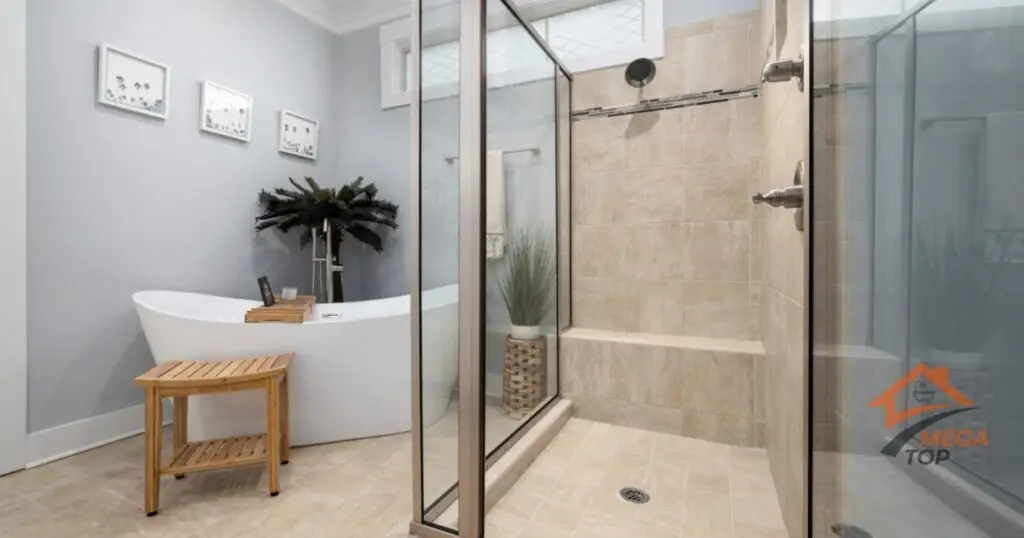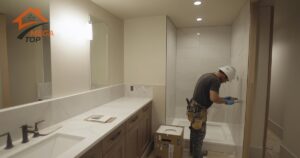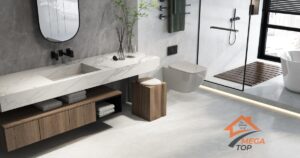1. Why Shower Waterproofing is Essential
Waterproofing is one of the most important steps in building or renovating a shower. Without proper waterproofing, moisture can seep into the walls and floors, leading to significant structural damage, mold growth, and costly repairs. A shower waterproofing membrane is key to protecting the area from water infiltration and ensuring that your shower remains leak-free for years.
The Risks of Poor Waterproofing
When a shower isn’t properly waterproofed, several problems can arise:
- Water infiltration: Water can seep into cracks or unsealed areas, leading to damage to the underlying structure.
- Mold and mildew: Prolonged exposure to moisture creates the perfect environment for mold and mildew to grow, which can cause health issues.
- Costly repairs: Repairing water damage is expensive, especially if it goes unnoticed for a long period. Replacing damaged tiles, walls, and flooring can be avoided with proper waterproofing.
Benefits of Proper Waterproofing
- Prevents water damage: A complete waterproofing system keeps water out of walls and flooring, protecting the shower’s integrity.
- Increases longevity: A well-waterproofed shower lasts longer, with fewer issues like leaks or cracking tiles.
- Saves money: Proper waterproofing reduces the risk of expensive repairs and maintains the quality of your shower installation over time.
2. Preparing the Shower Area for Waterproofing
Before applying a waterproofing membrane, the shower area must be properly prepared. Ensuring a clean, dry, and even surface is essential for the membrane to adhere correctly.
Cleaning and Prepping the Surface
- Remove old materials: Before applying any waterproofing, remove old tiles, grout, and adhesive. The surface must be free of debris for the waterproofing membrane to bond effectively.
- Clean thoroughly: Use a vacuum and cloth to clean all surfaces, ensuring they are free of dust, dirt, or any loose particles.
- Ensure the surface is dry: Moisture in the wall or floor can compromise the waterproofing process. Allow the shower area to dry completely before applying any membrane.
Inspecting for Pre-existing Damage
It’s important to inspect the walls and floor for cracks, holes, or other damage before waterproofing.
- Check for structural issues: Repair any visible cracks or gaps in the walls and floor to create a stable base for the membrane.
- Fix damage: If the subfloor or wall has water damage, it must be addressed before starting the waterproofing process.
3. Choosing the Right Shower Waterproofing Membrane
There are different types of waterproofing membranes available for showers, each with its pros and cons. Selecting the right one is crucial for achieving a long-lasting, water-tight installation.
Types of Waterproofing Membranes
- Sheet membranes: These are large sheets of waterproof material, often made from PVC or polyethylene, that are applied directly to the shower walls and floor. They provide excellent protection but require precise installation.
- Liquid membranes: Liquid waterproofing membranes are applied with a brush or roller and create a seamless, flexible barrier. They are easier to apply but may require multiple coats to ensure complete coverage.
Tools and Materials Needed
To complete the waterproofing, gather the necessary tools and materials:
- Trowels for applying adhesive
- Rollers or brushes for liquid membrane application
- Waterproofing tape for sealing joints and corners
- Sealants for extra protection around vulnerable areas such as drains and pipes
- Backer boards to create a stable surface for the membrane in areas that need reinforcement
4. Applying the Waterproofing Membrane
Proper application of the membrane ensures complete waterproofing of the shower. Whether using a liquid or sheet membrane, following the correct steps is crucial.
Step-by-Step Process for Liquid Membrane Application
- Apply a primer to the surface if required by the product.
- Use a roller or brush to spread the liquid membrane over the walls and floor, ensuring even coverage.
- Apply multiple coats: Most liquid membranes require at least two coats. Apply the second coat perpendicular to the first to ensure complete coverage.
- Allow adequate drying time between coats, as specified by the manufacturer.
Installing a Sheet Waterproofing Membrane
- Cut the membrane to size for the walls and floor, ensuring it fits snugly in the corners.
- Apply adhesive to the surface using a trowel, and press the sheet membrane onto the adhesive, smoothing out air bubbles.
- Seal seams and corners: Use waterproof tape to seal the seams between membrane sheets and reinforce corners for maximum protection.
5. Sealing Joints, Corners, and Edges
Even with a waterproofing membrane in place, joints, corners, and edges are particularly vulnerable to leaks. Special attention must be paid to these areas during the waterproofing process.
Using Waterproof Tape for Extra Protection
- Apply waterproof tape to all joints, corners, and where the walls meet the floor. This prevents water from seeping into small gaps that the membrane alone may not cover.
- Ensure a tight seal around drains and pipes by applying extra tape or sealant around these areas.
Installing Waterproof Grout and Sealing Tiles
- Use waterproof grout when tiling over the waterproofed surface. This provides an additional layer of protection, preventing water from penetrating the grout lines.
- Seal the grout after it has dried to further waterproof the tiles and grout lines. Regularly reapply sealant to maintain protection over time.
6. Waterproofing the Shower Floor and Drain
Waterproofing the floor and ensuring proper drainage are key to preventing water from accumulating and causing damage.
Installing a Shower Pan or Liner
- Install a shower pan or liner before applying the membrane to ensure that water flows correctly to the drain. A sloped floor is essential for proper drainage.
- Check the pan or liner for any holes or defects before installation. The liner should extend up the walls several inches to create a watertight barrier.
Testing the Waterproofing Before Tiling
Once the membrane is installed, a flood test should be conducted to check for leaks:
- Flood the shower base with water and let it sit for 24 hours.
- Inspect for leaks around seams, corners, and edges. If any leaks are detected, fix them before proceeding with tile installation.
7. Final Steps: Installing and Sealing the Tiles
After the waterproofing membrane has been applied and tested, it’s time to tile the shower. Proper installation and sealing of the tiles ensure that your shower remains waterproof.
Choosing the Right Tiles for Waterproofing
- Select non-porous tiles, such as ceramic or porcelain, for the best water resistance.
- Ensure proper tile adhesion: Use waterproof adhesive to ensure the tiles bond securely to the waterproofing membrane.
Post-Installation Checks and Maintenance
- Inspect for any remaining gaps or areas that may be prone to leaks.
- Maintain the waterproofing: Over time, resealing grout and tiles will help maintain the waterproof barrier.
DIY vs Professional Waterproofing: What’s Best?
Waterproofing a shower can be done as a DIY project, but there are risks involved. Incorrect waterproofing can lead to leaks and extensive water damage, which are costly to repair.
Challenges of DIY Shower Waterproofing
- Inaccurate application: Small mistakes, such as improperly sealing seams or failing to test for leaks, can lead to major water damage.
- Lack of proper tools: Without the right tools and materials, DIY waterproofing may not last as long as professional installations.
Benefits of Hiring a Professional for Waterproofing
- Expert application: Professionals have the experience and tools needed to ensure a thorough, long-lasting waterproof installation.
- Avoiding costly mistakes: By hiring a professional, you reduce the risk of leaks, water damage, and the need for future repairs.
- Peace of mind: Professional installers often offer warranties on their work, providing long-term protection against leaks and water damage.
Waterproofing is an essential step in creating a long-lasting, leak-free shower. To ensure the best results, consider hiring a professional waterproofing expert today!
FAQ
A waterproofing membrane prevents water from penetrating the walls and floor, which can lead to structural damage, mold, and leaks.
Yes, with the right tools and knowledge, DIY installation is possible. However, hiring a professional ensures a perfect installation and long-lasting results.
Sheet membranes offer durability, while liquid membranes provide ease of application. The best choice depends on your shower's specific needs.
It’s recommended to waterproof the entire shower, including walls, floor, and corners, to prevent any risk of water damage.
Properly applied waterproofing can last 10 to 20 years, but regular maintenance, such as resealing tiles and grout, is essential for longevity.





